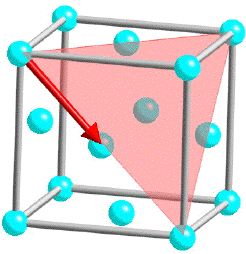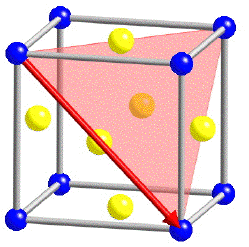
Nickel based superalloys are particularly important in the manufacture of aeroengines and industrial gas turbines.
The transmission electron micrograph below is taken from a nickel-based superalloy, known commercially as 'C263'. The alloy is used in the manufacture of gas turbine combustion chambers. It was heat treated at 800oC for 8 h, with an initial average ![]() size of about 22 nm. The fraction of
size of about 22 nm. The fraction of ![]() is 0.1. The alloy was creep tested at
800oC at a stress of 160 MPa for about 2.5 days. The creep strain recorded was about 0.7%. The micrograph shows the dislocation structure following creep, with dislocations looping around the
is 0.1. The alloy was creep tested at
800oC at a stress of 160 MPa for about 2.5 days. The creep strain recorded was about 0.7%. The micrograph shows the dislocation structure following creep, with dislocations looping around the ![]() particles.
particles.
Notice that the dislocations in the image are paired-loops (i.e. superdislocation loops).
In all nickel based superalloys, the presence of the ![]() phase
hinders the motion of dislocations even though it is coherent with the
matrix. This is because it has an ordered crystal structure. In
phase
hinders the motion of dislocations even though it is coherent with the
matrix. This is because it has an ordered crystal structure. In ![]() the Burgers vector of a dislocation is
the Burgers vector of a dislocation is
![]() ; this is, of
course, a lattice vector so that slip does not alter the crystal
structure. However, for
; this is, of
course, a lattice vector so that slip does not alter the crystal
structure. However, for ![]()
![]() is not a lattice
vector -
is not a lattice
vector - ![]() is the lattice vector for a primitive cubic
lattice. It follows that the motion of an
is the lattice vector for a primitive cubic
lattice. It follows that the motion of an
![]() dislocation into the
dislocation into the ![]() will disrupt the order, leaving behind an
anti-phase domain boundary. However, the passage of a second such
dislocation through
will disrupt the order, leaving behind an
anti-phase domain boundary. However, the passage of a second such
dislocation through ![]() on the same slip plane restores the order.
on the same slip plane restores the order.
As a consequence, the penetration of ![]() has to occur by pairs of
has to occur by pairs of
![]() dislocations. Such pairs are called `superdislocations'.
The requirement for pairing makes it more difficult for dislocations to
penetrate the
dislocations. Such pairs are called `superdislocations'.
The requirement for pairing makes it more difficult for dislocations to
penetrate the ![]() and hence improves the resistance to creep
deformation.
and hence improves the resistance to creep
deformation.
Lattice vectors along <110> directions in γ and γ', lying on { 111 } planes. The γ on the left has a random distribution of Ni, Al and Ti atoms, whereas the γ' on the right has its nickel atoms located at the face-centres. |
 |
 |
Download high resoultion TIF file of transmission electron micrograph.
The micrograph has been provided for teaching purposes by Dr Yanhui Zhang.
| PT Group Home | Materials Algorithms |

|

|